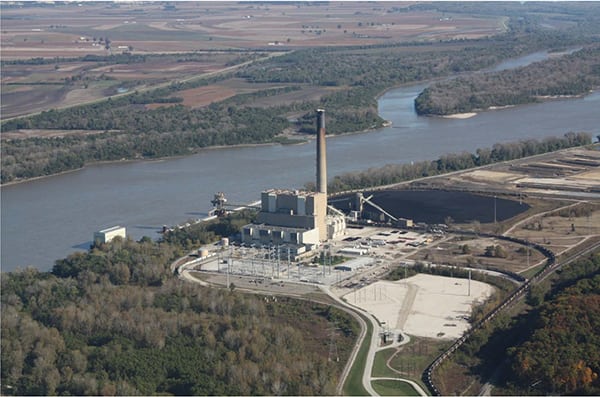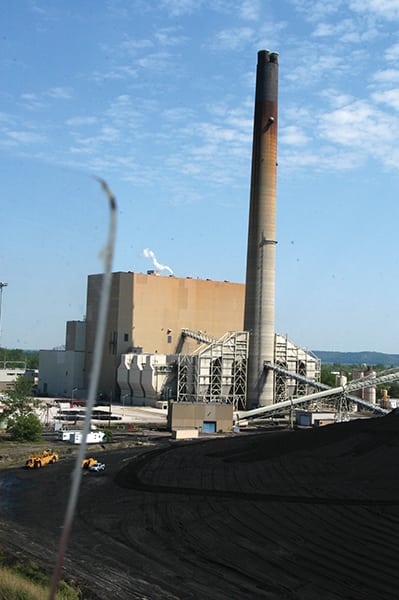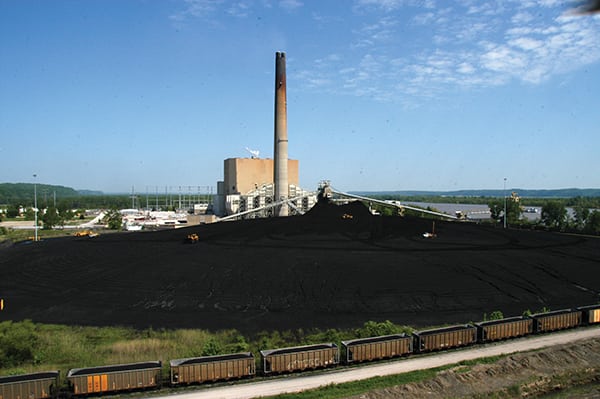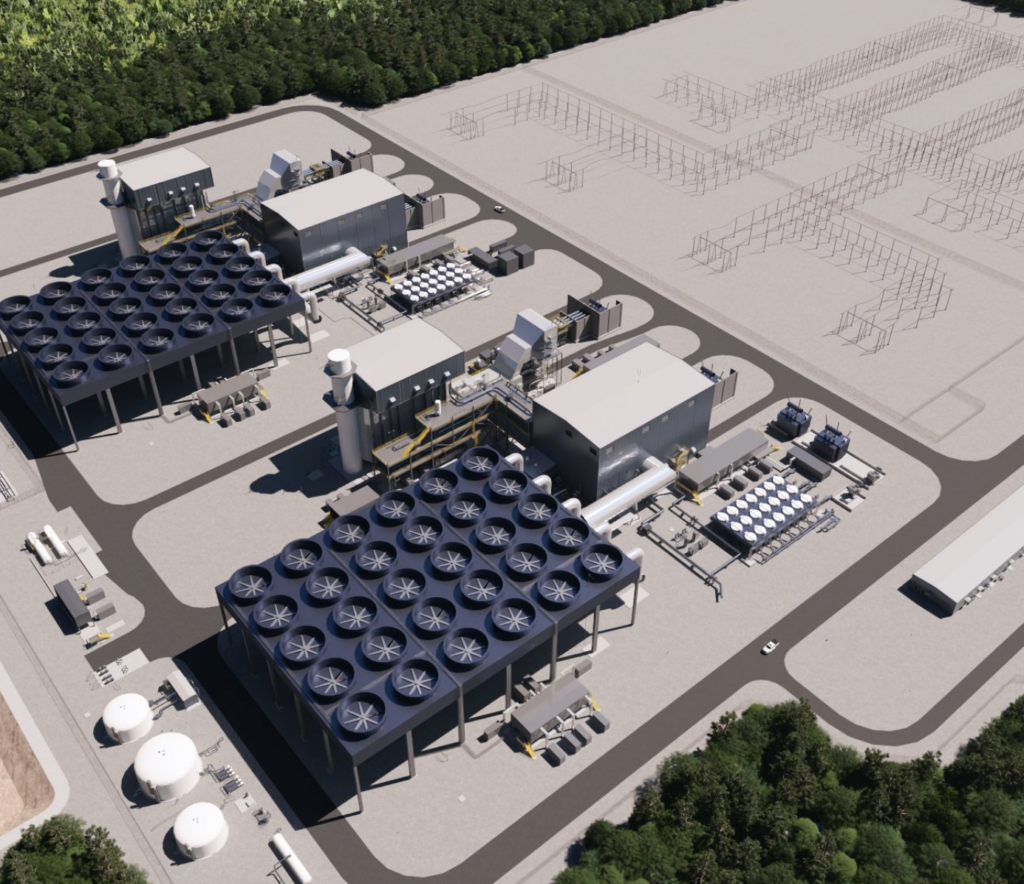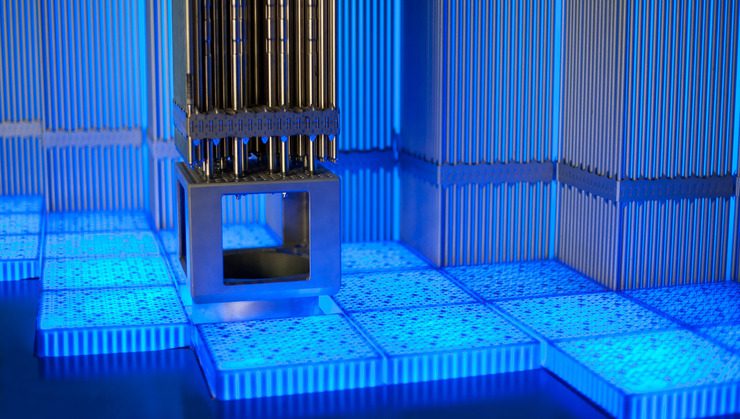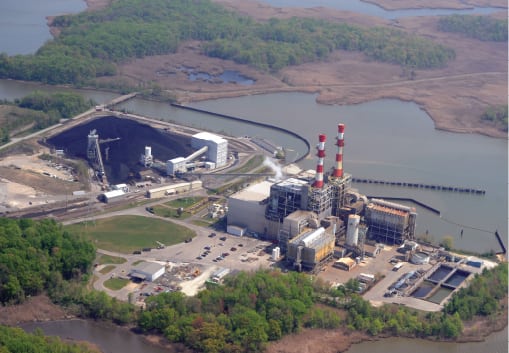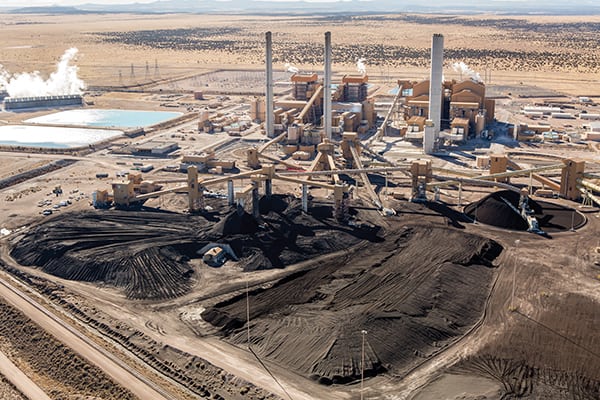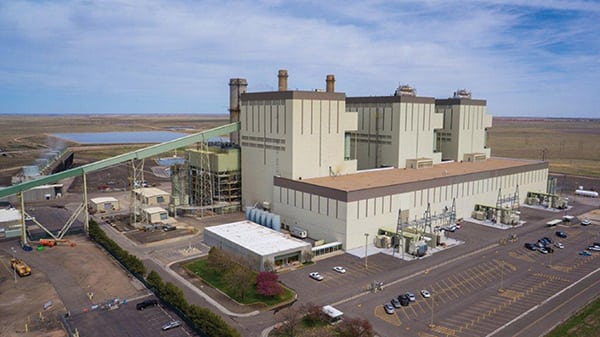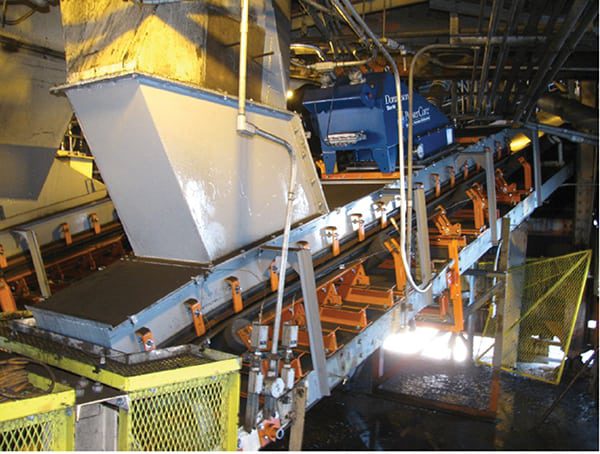Rush Island Energy Center has successfully fired Powder River Basin (PRB) coal for two decades, as proven by the plant’s excellent performance stats, dedication to minimizing its environmental footprint, and sterling safety record. The PRB Coal Users’ Group top award recognizes the plant staff’s long-term dedication to continuously improving its safe handling and efficient combustion of PRB coal.
“Without continual growth and progress, such words as improvement, achievement, and success have no meaning,” Benjamin Franklin once said. Franklin, inventor and statesman, knew the value of improving electricity systems and in the process of his electricity experiments coined terms such as “battery,” “charge,” “condenser,” and “armature,” among many others. Franklin began with an idea that would benefit society (he never patented an invention) and then slowly perfected the product. The best-performing power plants, such as Ameren’s Rush Island Energy Center (RIEC), reap the rewards of following Franklin’s example.
In May, RIEC celebrated 40 years of providing reliable, safe, and low-cost power to its Missouri customers. Over 20 years ago, RIEC began making the switch to Powder River Basin (PRB) coal because of the coal’s environmental and economic advantages (the coal contains very low amounts of sulfur and is the lowest $/Btu fuel). The plant has burned 100% PRB coal since 1996. Today, PRB coal is further refined on site with the addition of proprietary chemicals that “refine” the coal in order to reduce NOx production at a cost of about $4 million per year. RIEC’s two units routinely score first and second nationally for the lowest NOx produced by units without selective catalytic reduction (SCR).
RIEC is located about 45 miles south of St. Louis, Mo., on a 500-acre site, on the west side of the Mississippi River. Each unit has a gross generating capacity of approximately 645 MW. The two units began commercial service in 1976 and 1977 and represent the last coal plants constructed for the Ameren Missouri generating fleet. The tangentially fired boilers were originally designed to burn high-sulfur Illinois coal (11,600 Btu/lb versus 8,400 Btu/lb for PRB coal). The plant produces electricity with two Westinghouse turbine-generators, recently upgraded with Alstom rotors.
The Powder River Coal Users’ Group (PRBCUG) Board of Directors toured RIEC in mid-December 2015 to learn first-hand about the plant’s progress toward implementing best practices for managing risk, ensuring a safe working environment, efficient combustion, and PRB coal handling. Board members shared their observations with POWER, many of which are included in this article. The common denominator reported by each member of the review team was the plant’s commitment to a process of continuous improvement in all areas of plant operations.
Excellence in plant operations is a process, not an end state, although Plant of the Year honors certainly represent a significant milestone in the life of the plant (see sidebar). The board noted three important areas where the plant distinguishes itself among its peers: environmental performance, plant operations, and a culture of safety.
|
PRBCUG Recognizes Its 2016 Plant of the Year The annual Powder River Basin Coal Users’ Group (PRBCUG) meeting was held in April in conjunction with the 2016 ELECTRIC POWER Conference & Exhibition in New Orleans, La. This year the PRBCUG recognized the Rush Island Energy Center as its Plant of the Year for the plant’s innovation and implementation of “best practices and best available technologies” for burning PRB coal. Plant of the Year recipients are inducted into the group’s Power Plant Hall of Fame. Selections are made by the group’s board of directors, with input from members. PRBCUG membership comprises users of PRB coals as well as prospective consumers (generating companies or industrial energy consumers). Associate members from companies supplying coal, equipment, or services also participate in the selection process. Visit www.prbcoals.com for more information about the group and its Plant of the Year selection process. |
Environmental Excellence
NOx emissions are managed by overfired air and a Griffin neural net combustion optimization system. The permit limit for NOx emissions is 0.40 lb/MMBtu, although actual average annual NOx emissions have remained below 0.10 lb/MMBtu over the past decade, without an SCR. For 2015, NOx emissions averaged 0.081 lb/MMBtu. Particulates are captured with an electrostatic precipitator on each unit (there is no baghouse).
The plant’s sulfur emissions rely on the efficient burning of the ultra-low-sulfur PRB compliance coal. Permitted SO2 emissions are 2.3 lb/MMBtu, although the plant’s average annual emissions have tracked under 0.75 lb/MMBtu for the past 20 years, dipping to below 0.5 lb/million Btu in 2014 as combustion systems were continuously optimized.
Mercury emissions are reduced by injecting activated carbon upstream of the air heaters and a mercury continuous emissions monitoring system analyzes the stack gas. The plant closely manages opacity exceedances and had only 46 six-minute exceedances in 2014.
The plant operates today with a capacity factor over 80% and an equivalent availability just short of 90%.
Impeccable Plant Operations
RIEC’s two units consume about 5.5 million tons of PRB coal each year, which represents about one 145-car unit train every day. Coal is sourced from Peabody Energy’s North Antelope Rochelle, Seam “C,” located in Wyoming. A loop track around the storage area reduces the coal train unloading cycle time.
The plant stores about 1.1 million tons of coal on site (equivalent to about 60 to 65 days of consumption). Coal is delivered using pneumatically actuated bottom-dump cars that drop coal onto feeders. An “A-frame” structure supports a vibratory shaker that, with an electric heater, is able to remove sticky, wet, or frozen coal from the rail cars. Dry roto-clone systems keep the dust produced during the unloading process well under control. A surfactant is also sprayed on the coal during unloading for dust control, when required.
The “A” side coal unloading system is configured with below-grade dump hoppers outfitted with vibratory feeders that direct coal onto conveyor belt systems that terminate at the radial stacker-reclaimer centrally located in the main coal storage pile (Figure 1). The conveyor belt is protected with a fixed nozzle, open spray deluge system monitored and triggered by a thermistor wire. The coal bins are located indoors, although the filter houses are outdoors. Once coal is delivered to the pile, three Caterpillar D10 dozers keep the coal storage area well-groomed. The reclaim system collects coal from the pile and conveys it to the transfer house, where magnetic metal separation occurs. Coal is then conveyed to the surge bin located on each unit, which, in turn, sends coal to one of the six unit silos. The “B” side system, which is virtually identical in operation, provides redundancy.
The single coal supply incline from the transfer house to the boiler island contains two independent conveyor systems (Figure 2). The twin conveyors run through an engineered opening in the stack’s shell structure, through the stack, across the boiler house, and to the tripper (cascade) floor and the coal silos. The open conveyors are the cause of minor combustible dust releases within the building that are ably handled by the housekeeping staff.
As part of the plant’s conversion to PRB coal, conveyor side panels and under-conveyor dribble and sluice pans were installed on the two conveyors. The side panels prevent coal particles from escaping into the boiler house, and the dribble and sluice pans help capture and direct washdown slurry to a containment area outside the boiler building. Washing of these conveyors occurs every two weeks, or more often, as needed.
A crew of 10 laborers are assigned housekeeping duties for the fuel unloading and delivery systems. The normal practice is to wash down unloading areas of combustible dust after each train is unloaded. Washdown in the fuel unloading area relies on hoses. Washdowns on the tripper deck with hoses and a floor deluge system are conducted once a week. Monthly housekeeping audits are also performed by craft supervisors.
Fire protection water is supplied by three pumps; two are electric drive and one is driven by a diesel engine. Pumps are tested weekly. The plant’s fire control panel is located within the combined control room and is monitored around the clock by the control room operators.
Organized for Success
RIEC employs 141 full-time employees. The plant’s operations and maintenance (O&M) staff is organized with five rotating operations teams, plus 45 maintenance craft workers and 10 fuel operators. All plant operators are also cross-trained in a maintenance skill and spend approximately one-half of their shift performing plant maintenance. Ameren also has a traveling maintenance group of approximately 70 craft workers that augment the plant maintenance staff during major maintenance outages.
Boiler outages are scheduled every six years and turbine outages every 12 years. The plant’s annual O&M budget (less fuel) is approximately $24 million, and the capital budget is about $2.5 million, which doesn’t include major capital projects.
The plant’s outstanding safety record is demonstrated by just six lost work accidents occurring over the past 10 years. An effective safety culture begins at the top. Litzinger hosts a monthly all-hands safety meeting that is also video recorded for replay by shift workers. Other important safety programs include:
■ The Plant Safety Steering Committee—consisting of senior plant staff, a craft representative, and a corporate safety representative—meets monthly. The craft safety representative is elected to serve in that position by peers.
■ The plant safety director conducts a daily safety tour of the plant, and all plant employees are trained to be vigilant in identifying potential safety issues.
■ “Stop work” authority is delegated to all employees when an unsafe condition is observed.
■ Contractors must submit a safety plan for approval prior to beginning work.
■ Of the 141 plant employees, 135 are emergency response trained.
■ The plant has a 40-member fire brigade for interior firefighting, and all employees are trained in incipient firefighting.
Workers participate in a safety observation program called Crew to Crew (C2C). C2C requires workers to complete a job briefing and hazard recognition form prior to the start of each job. If hazards are identified, they must be escalated to a supervisor for resolution. C2C also requires daily supervisor visits to every location in the plant where work is being performed. It is the supervisor’s responsibility to talk with those doing the work and, by using a prescribed check sheet, to identify emerging safety issues that require immediate attention, develop modifications to existing job plans, and/or identify future training needs.
Finally, IMPROVE, the plant’s work management system, is used to capture recognized hazards and near misses. The feedback is then reviewed by the appropriate craft supervisor and safety supervisor. The safety supervisor is responsible for recording, tracking, and disseminating all safety-related issues to the plant director and to other Ameren facilities.
Current Coal Challenges
RIEC has made many PRB coal-related improvements since converting the plant to burn PRB coal 20 years ago. Prime examples are the improvements made to its coal-handling systems, such as explosion-proof electrical system upgrades, installing semi-automatic washdown systems, dust suppression system additions, improved chute and skirt board seals, and fire protection system upgrades.
The plant also installed passive and fixed fire detection suppression systems throughout the plant and on its fuel-handling systems. Flow-controlled transfer chutes were installed so that the fuel-handling system would efficiently handle the increased coal flow. Upgrades were made to the plant’s bunkers, silos, and bins (silos) to reduce bridging and rat-holing. Erratic flow through silos is especially troublesome as PRB coal is more prone to spontaneous combustion during coal flow stoppages. Finally, coal conveyors along with the support structures were retrofitted with automatic fixed sprinkler systems.
For 2016, the plant’s continuous improvement program is focused on improving plant operations in two important ways: reducing boiler fouling and reducing fly ash dusting originating at coal mill primary air ducts.
Reduce Furnace Fouling. Effective furnace sootblowing is required in order to keep the furnace tubes clean. Each unit uses 80 steam wallblowers and long retractable blowers (recently increased from 18 to 66) for tube wall cleaning, a mixture of Copes-Vulcan and Clyde Bergemann designs. Three additional long retractable sootblowers are currently planned for installation on each unit. Steam is the sootblowing medium of choice.
The Griffin intelligent combustion control system is also used for intelligent sootblowing (ISB). The ISB is principally used to determine cleaning times and intervals, although operators must occasionally manually run select blowers to manage steam temperature control. Periodic load drops are intermittently required for slag shedding, particularly during summer months after a long run at—or long periods of operation at or near—full load. Online boiler washdowns are scheduled about twice a year.
Routine maintenance of sootblowers was problematic, so a few years ago RIEC set up a dedicated sootblower maintenance shop. Sootblower availability was greatly improved as a result of having the dedicated maintenance shop. On the day of the visit, Unit 1 had only three of 80 wall blowers out of service, three more wall blowers were available for local start only, and only one long retractable sootblower was out of service. On Unit 2, only three wallblowers were out of service.
Reduce Fly Ash Leaks.The plant maintenance staff has been fighting leaks in the primary air ducts that cause fly ash to be exhausted into the boiler house for the past three years. The problem often overwhelms the plant’s housekeeping staff because airborne fly ash tends to settle everywhere in the boiler house, and the turbine deck often receives a light dusting as well. Recent work completed on Unit 1 is expected to significantly reduce the dusting problem, and Unit 2 modifications will be completed during the unit’s next major outage. Fly ash does not have the fire hazard potential of PRB coal dust, so the presence of fly ash is principally a worker respiratory hazard concern.
More Information
Congratulations from the editorial staff of POWER to the management and staff of Ameren Missouri’s Rush Island Energy Center for being chosen as the 2016 PRBCUG Plant of the Year! For further information on RIEC or the plant improvement projects outlined in this article, please contact Plant Director Mark Litzinger (314-992-9201 or mlitzinger@ameren.com). Additional information on the PRBCUG and its awards program is available at www.prbcoals.com. ■
—Dr. Robert Peltier, PE is POWER’s consulting editor. The members of the PRBCUG board of directors that visited the Rush Island Energy Center and contributed to this report include Bill Konefes (Georgia-Pacific and Chairman, PRBCUG); Andrew Dobrzanski (DTE Energy and Vice Chairman-Genco); Jim Wiseman (Wiseman Consulting Services and Vice Chairman-Industry); Erick Dieperink (Luminant); James Rauba (FM Global); Jeff Kite (Diamond Power International Inc.); and Greg Krieser (OPPD Omaha Public Power District).


